|
|
|
Sort Order |
|
|
|
Items / Page
|
|
|
|
|
|
|
| Srl | Item |
| 1 |
ID:
085256
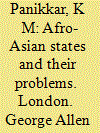

|
|
|
|
|
| Publication |
London, George Allen and Unwin Ltd., 1959.
|
| Description |
104p.
|
|
|
|
|
|
|
|
|
|
|
|
Copies: C:1/I:0,R:0,Q:0
Circulation
| Accession# | Call# | Current Location | Status | Policy | Location |
| 000457 | 309.15/PAN 000457 | Main | On Shelf | General | |
|
|
|
|
| 2 |
ID:
113867
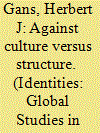

|
|
|
|
|
| Publication |
2012.
|
| Summary/Abstract |
Contemporary sociology is saddled with a culture-structure binary but the fault for its existence lies mostly with cultural sociology. This article is devoted to four related assertions: (1) There has never been any agreement on the definition of culture, making cultural sociology a field unable to define its central concept. (2) The binary ignores the fact that the proper explanation of social behaviour requires both structure and culture; culture cannot be its own cause. (3) Cultural sociology is soft and sentimental, avoiding conflict as well as politics. (4) It neglects policy and policy-relevant research even more than the rest of sociology. Structural sociology has some shortcomings as well, however, and the culture-structure binary should be abandoned.
|
|
|
|
|
|
|
|
|
|
|
|
|
|
|
|
| 3 |
ID:
109996
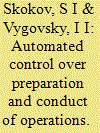

|
|
|
|
|
| Publication |
2011.
|
| Summary/Abstract |
The authors examine an automated control system for preparing and conducting military operations; and identify ways they consider essential for improving control efficiency.
|
|
|
|
|
|
|
|
|
|
|
|
|
|
|
|
| 4 |
ID:
158769
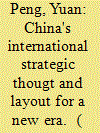

|
|
|
| 5 |
ID:
110831
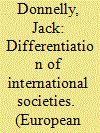

|
|
|
|
|
| Publication |
2012.
|
| Summary/Abstract |
Taking off from a recent article in this journal by Barry Buzan and Mathias Albert, I present a framework of structural differentiation as an alternative to IR's standard tripartite conception of the elements of structure. Rather than employ ideal type models, though, as Buzan and Albert do, I present a more open-textured, multidimensional account of differentiation. I also emphasize the systemic nature of structural analysis. The elements of structure are interdependent parts of wholes (systems) - not the independent variables implied by standard formulations such as 'the effects of anarchy'. A multidimensional systemic approach directs our attention to the diversity of and change in international systems and their structures, which mainstream structural IR typically ignores or obscures. I illustrate both the regularity of extensive structural change and the analytical utility of my differentiation framework with case studies of post-World War II international society and contemporary processes of globalization.
|
|
|
|
|
|
|
|
|
|
|
|
|
|
|
|
| 6 |
ID:
173802


|
|
|
|
|
| Summary/Abstract |
The problematics of a rearming Japan continue to be a jigsaw given its pacifist orientation. Japan had brought about the changes in its security policy citing new security challenges posed by burgeoning China and an unpredictable nuclear North Korea, despite the US nuclear umbrella. This paper investigates as to whether Waltzian structural logic can still explain the changes in Japan’s behaviour in the post-11 September 2001 global order. Japan has used the sanction to participate in collective security to modify its military doctrine for a more active role in the use and deployment of Self-Defence Forces and acquisition of offensive weapons. Yet, despite the prevalence of necessary conditions and, as a result, the increased vulnerability to its security, Japan has not breached the nuclear threshold, as Waltzian structural logic had predicted. Japan only managed to augment its military capabilities and ease the constitutional restrictions on use of force to a certain extent.
|
|
|
|
|
|
|
|
|
|
|
|
|
|
|
|
| 7 |
ID:
116593
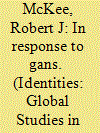

|
|
|
|
|
| Publication |
2012.
|
| Summary/Abstract |
Gans (2012; Against culture versus structure. Identities: Global Studies in Culture and Power, 19 (2), 125-134) makes four assertions in his claim that 'Contemporary sociology is saddled with a culture-structure binary but the fault for its existence lies mostly with cultural sociology … and the culture-structure binary should be abandoned'. I argue that (1) defining culture, while problematic, is insufficient reason for abandoning the concept. (2) Marx, among others, proffered a dialectical view of culture that is not structural only or interpretive only. (3) Gans ignores the social and political impact of cultural studies, specifically the Birmingham Centre for Contemporary Cultural Studies. And (4) culturally oriented research has been used extensively to shape and analyse the varying approaches by public policy-makers to critical social issues.
|
|
|
|
|
|
|
|
|
|
|
|
|
|
|
|
| 8 |
ID:
150501
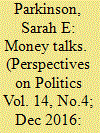

|
|
|
|
|
| Summary/Abstract |
Scholarship on militant organizations and rebel movements emphasizes the effects of fragmentation and disunity on military and political outcomes. Yet this scholarship’s focus on formal, durable, and externally observable aspects of organizational structure omits the social practices that constitute, reinforce, and reproduce intra-group schisms. How do intra-organizational divisions calcify into permanent cleavages? What processes reproduce factions over time? Using the case of Fatah in Lebanon, I argue that informal discursive practices—e.g., gossip, jokes, complaints, storytelling—contribute to the maintenance and reproduction of intra-organizational factions. Specifically, I focus on how networks of meaning-laden, money-centric discourse structure relations among militants who identify as being “Old Fatah.” I demonstrate that while these practices frequently originate in the organizational realm, cadres subsequently reproduce them within kinship, marriage, and friendship networks. This “money talk” between age cohorts within the quotidian realm connects younger members of Fatah to older cadres through collective practices and conceptions of organizational membership. These practices both exemplify an intra-organizational schism and constitute, in part, the faction called Old Fatah. Examining how symbolic practice comprises social structure thus provides important insight into the politics of organizations such as militant groups, social movements, and political parties.
|
|
|
|
|
|
|
|
|
|
|
|
|
|
|
|
| 9 |
ID:
086898
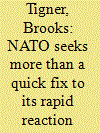

|
|
|
|
|
| Publication |
2009.
|
| Summary/Abstract |
NATO's goal of moving away from its geographically oriented Cold War command structure to one that is lighter, more flexible and more responsive to international crises has been, at best, limited and slow-going and, at worst, fiercely resisted by national militaries fearful of losing jobs and relevance.
|
|
|
|
|
|
|
|
|
|
|
|
|
|
|
|
| 10 |
ID:
109858
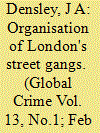

|
|
|
|
|
| Publication |
2012.
|
| Summary/Abstract |
This article examines a grossly neglected area of the street gang literature: the nature and extent of gang organisation. Based upon fieldwork with gangs in London, UK, this article illustrates how recreation, crime, and enterprise are not specific gang 'types', but rather represent sequential stages in the evolutionary cycle of gangs. This article demonstrates not only how gangs typically begin life as neighbourhood-based peer groups, but also how, in response to external threats and financial commitments, gangs grow to incorporate street-level drug distribution businesses that very much resemble the multi-level marketing structure of direct-selling companies. Gang organisation, in turn, becomes a function of gang business. Gang organisation is conceptualised here on three levels: internal, external, and symbolic. This article examines, respectively, the presence of subgroups, hierarchy and leadership, incentives, rules, responsibilities, and punishments within gangs; how gangs interact with the local and larger community; and how gangs associate with symbolic elements of popular culture in order to convey reputation and achieve intimidation.
|
|
|
|
|
|
|
|
|
|
|
|
|
|
|
|
| 11 |
ID:
144346
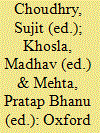

|
|
|
|
|
| Publication |
New Delhi, Oxford University Press, 2016.
|
| Description |
lxv, 1048p.pbk
|
| Standard Number |
9780198787334
|
|
|
|
|
|
|
|
|
|
|
|
Copies: C:1/I:0,R:1,Q:0
Circulation
| Accession# | Call# | Current Location | Status | Policy | Location |
| 058626 | 342.54/CHO 058626 | Main | On Shelf | Reference books | |
|
|
|
|
| 12 |
ID:
098965
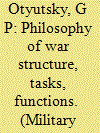

|
|
|
| 13 |
ID:
174062
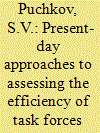

|
|
|
|
|
| Summary/Abstract |
This paper suggests a system of indices for assessing the functioning efficiency of the task forces control systems whose employment helps take into consideration the effect of basic factors in the control process.
|
|
|
|
|
|
|
|
|
|
|
|
|
|
|
|
| 14 |
ID:
168020
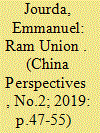

|
|
|
|
|
| Summary/Abstract |
The Ram Union is a non-profit social organisation established in 2003 in Zhejiang Province. Its transformation from a local entity into an international NGO tells us about the methods implemented by the Chinese Communist Party (CCP) to accompany the development of popular associations or minjian, which appear to be external to the Party but which in fact are fully sponsored by it. Studying such organisations is a complex matter, as they appear to act in a benevolent and apolitical manner, while being completely integrated within the political and social apparatus of the Party-state (Youth League, volunteers, United Front, ministry of Civil Affairs, etc.). The historical trajectory of the Ram Union thus gives us insight into the CCP’s overlooked strategy of hybridisation, involving mass organisations that came out of the revolutionary period and charitable groups embodying modern Chinese society. This strategy is designed to occupy the social arena and forestall the emergence of an autonomous Chinese civil society in the People’s Republic of China (PRC) or among the Chinese diaspora overseas.
|
|
|
|
|
|
|
|
|
|
|
|
|
|
|
|
| 15 |
ID:
179224
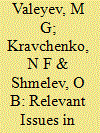

|
|
|
|
|
| Summary/Abstract |
This paper outlines the main problems in the formation of the initial data system covering RF AF facilities, economy, and infrastructure in the interests of organizing aerospace defense, and the methodological approaches to resolving these problems.
|
|
|
|
|
|
|
|
|
|
|
|
|
|
|
|
| 16 |
ID:
137662


|
|
|
|
|
| Summary/Abstract |
A major development in understanding the structure and organization of memory was the identification of the medial temporal lobe memory system as one of the brain systems that support memory. Work on this topic began in the 1950s with the study of the noted amnesic patient H.M. and culminated in studies of an animal model of human memory impairment in the nonhuman primate. These discoveries opened new frontiers of research concerned with the functional specialization of structures within the medial temporal lobe, the existence of multiple memory systems, the process of memory consolidation, and the role of neural replay and sleep in the consolidation process. This work also led to new insights about how and where memories are ultimately stored in the brain. All of this research has improved our understanding of how memory is affected by normal aging and why it is so profoundly impaired by the pathological processes associated with dementia.
|
|
|
|
|
|
|
|
|
|
|
|
|
|
|
|
| 17 |
ID:
155129
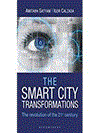

|
|
|
|
|
| Publication |
New Delhi, Bloomsbury, 2017.
|
| Description |
xi, 333p.pbk
|
| Standard Number |
9789386349040
|
|
|
|
|
|
|
|
|
|
|
|
Copies: C:1/I:0,R:0,Q:0
Circulation
| Accession# | Call# | Current Location | Status | Policy | Location |
| 059201 | 352.23216/SAT 059201 | Main | On Shelf | General | |
|
|
|
|
| 18 |
ID:
116595
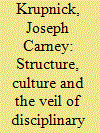

|
|
|
| 19 |
ID:
072114
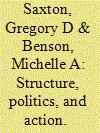

|
|
|
|
|
| Publication |
2006.
|
| Summary/Abstract |
This article presents an integrated model of contentious nationalist activity, with structure, politics, and action assuming equal roles in an interdependent causal system. The model is tested using simultaneous equation systems on 130 ethno-nationalist groups from 1990 to 1998. The results confirm the vital, indirect role of grievances and group identity on protest and the powerful direct and indirect effects of political opportunity structure variables on protest and rebellion. Repression is shown to have a particularly escalatory impact on the conflict process.
|
|
|
|
|
|
|
|
|
|
|
|
|
|
|
|
| 20 |
ID:
090143
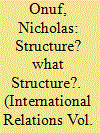

|
|
|
|
|
| Publication |
2009.
|
| Summary/Abstract |
Kenneth Waltz is a structural theorist. While scholars often comment on Waltz's conception of structure, they rarely address the philosophical assumptions behind it - assumptions that go back to Kant and finally to Aristotle. Appropriately situated, Waltz's conception of structure points to a strong version of constructivist social theory. To make my case, I trace Waltz's view of political structure in his early work, recapitulate his views on science, models and theory, address the question of his (or any) theory's relation to `reality', illustrate his difficulty with structural theory and institutional reality, and consider the vexed question of any theory's fit to a world already talked into existence. I show how close Waltz is to a philosophical position that solves his problem with theory's relation to reality and specifies the conditions under which any social theory can make sense or use of the term structure.
|
|
|
|
|
|
|
|
|
|
|
|
|
|
|
|
|
|
|
|
|